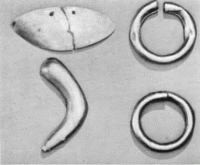Tucson archaeologist says she found Coronado Expedition artifacts (azcentral.com)
There seems to be no doubt that the first mention and identification of platinum in European literature is that by the Spanish officer and scientist, Don Antonio de Ulloa, in the book published in 1748 which described his visit to New Granada and other parts of the Spanish empire in South America in 1736–1746 (1). What he said was: “In the district of Choco are many mines of lavadero or wash gold … several mines have been abandoned on account of the platina.”After the Inca invasion in the fifteenth century the newcomers took over the alloying technique and in due course the Spaniards, after their conquest in 1526, developed it into a manufacture of sword-hilts, buckles, snuffboxes and other such objects. There are several mentions of these things in the literature, with sometimes the comment that the alloy was “a brittle metal although heavier than gold”. E. P. C. Meyer, writing of the Spanish archives (5), mentions that some of these documents “refer to the shipment of quite large quantities (in one case 18 lb) of alloyed metal which was called platina”; he attaches the date of 1735 to this statement. William Brownrigg, writing in 1750 (6), states that “the Spaniards have a way of melting it down either alone or by means of some flux; and cast it into sword-hilts … and other utensils; … A gentleman of Jamaica bought five pounds of it at Carthagena for less than its weight of silver and it was formerly sold for a much lower price”.
D. J. Krunitz, writing in the Hamburgisches Magazin for 1759 (7) refers to the Spanish alloy thus: as these (the hilts etc.) “do not lose their brilliance in the air and do not become tarnished or rusty, excellent concave mirrors for telescopes can be made from this metal. When it is mixed with copper the corrosion of the latter is hindered and, without diminishing its malleability, a hardness and density is conferred which enables the metal to be used for several purposes to which copper itself cannot be applied”. Finally, the Abbé Rochon reports as follows (8): “During the time I resided at Corunna in 1770 the Intendant General of Galicia … made me a present of a small ingot of platina which was combined with a great deal of zinc and red copper; this ingot, which weighed about 8 ounces, was in Spain considered as a very rare and curious specimen. Buffon afterwards gave me two dishes of a mixture altogether similar which had been manufactured at Lima.” Later the Abbé was himself making reflectors for telescopes out of an alloy of platinum with copper, arsenic and tin...
 |
| Platinum-surfaced gold pendants and platinum nose rings made by pre-Columbian Indians, found at La Tolita in Ecuador and now preserved in the Museum of the American Indian, New York |
Here is the link if you want to read the entire article.
The Platinum of New Granada - technology.matthey.com
Platinum is definitely a seldom-mentioned metal when talking about Treasure Coast shipwreck coins and artifacts but is definitely something to consider. It can go unrecognized in artifacts unless an effective analysis is conducted.
---
Don't forget about the original blog treasruebeachesreport.blogspot.com. You can find many older posts there. It is still read daily by hundreds of readers.
---
 |
| Source: MagicSeaweed.com. |
Looks like we'll have a bigger surf early next week. Six - ten feet is getting up therre. There are still a few days for the prediction to change, and there are other factors to consider. The tides and winds will have an effect too. But right now it is certainly looking interesting.
Good hunting,
Treasureguide@comcast.net
